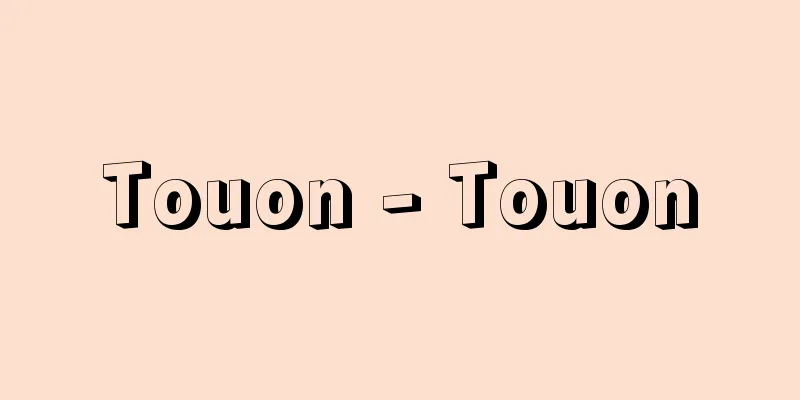Touon - Touon

〘Noun〙① Generally refers to Chinese pronunciation. ※Siddham Yoketsu (around 1101) 3 "Denpo Daishi used Tang pronunciation and transmitted it to Japan at one time, but there is also Tang pronunciation . "② = Kan'on (Chinese pronunciation)② ※Meigoki (1275) 4 "Rei is a bell.〈Omitted〉In pronunciation it is called ryau, and in Tang pronunciation it is called rei."③ A type of Japanese Chinese character pronunciation. In the narrow sense, it is based on the pronunciation of characters from southern China from the Ming to the early Qing dynasties, which was introduced by Zen monks, traders, Nagasaki interpreters, etc. during the Edo period. In a broad sense, it is the same as "Tang Song pronunciation." It is used in contrast to Kan'on and Go'on. [Meigoki (1275)] *Shiji Sho (1477) 10 " Ke is the Go pronunciation. In Kan pronunciation it is read as ka . In Tang pronunciation it is called kya ." ④ The Chinese word is generally used. *Zappai - Pine Rain (1750) "How do you say nasty in Tang pronunciation?"Tou- in tau… [Tang sound, Tang rhyme ]Source: The Selected Edition of the Japanese Language Dictionary About the Selected Edition of the Japanese Language Dictionary Information |
〘名〙① 中国語音のことを一般にいう。※悉曇要訣(1101頃)三「伝法大師以二唐音一伝二和国一時、雖レ用二和音一亦有二唐音一」② =かんおん(漢音)②※名語記(1275)四「れいは鈴也。〈略〉音にはりゃうといひ、唐音にはれいといへる也」③ 日本の漢字音の一種。狭義には、江戸時代、禅僧、貿易商人、長崎通事などによって伝えられた明から清初にかけての中国の南方系の字音によるもの。広義には「唐宋音」に同じ。漢音・呉音などに対していう。〔名語記(1275)〕※史記抄(1477)一〇「家(け)は呉音なり。漢音は家(か)と読むそ。唐音には家(きゃ)と呼そ」④ 中国語を一般にいう。※雑俳・松の雨(1750か)「いやらしいとは唐音でどふ云ふへ」
とう‐いん タウ‥【唐音・唐韻ヰン】出典 精選版 日本国語大辞典精選版 日本国語大辞典について 情報 |
Recommend
Bos primigenius (English spelling)
...The cave paintings of Altamira, which are pain...
Awataguchimono - Awataguchimono
…In 1333 (Genko 3), the Imperial Court's Uchi...
Igaito
...The word "Kakiuchi" appears in docum...
Citrus leafhopper - Citrus leafhopper
…The Japanese staghorn leafhopper attacks grape l...
Edo Rinpa
…His representative works include the “Summer and...
Shimeji (Lyophyllum) - Shimeji (English spelling) Lyophyllum
A mushroom of the family Shimejiaceae in the order...
Sotogahama
A town in the northern part of the Tsugaru Peninsu...
Georgi Dimitrov
Leader of the Bulgarian Communist Party, General ...
Statue of Liberty
The Statue of Liberty is located on Liberty Island...
Relatives - Enja
〘noun〙① Someone who has a fateful connection with ...
Hiroo Onoda
He was a second lieutenant in the Imperial Japanes...
Official letter - official letter (English spelling)
In China, this is an old name for official documen...
Oromap - Oromap
…The northwest winter monsoon has a downwind natu...
Cancer Research Society
Founded in 1908 as the Department of Pathology at ...
Tax offender - tax offender
Crimes directly related to the imposition, collect...









